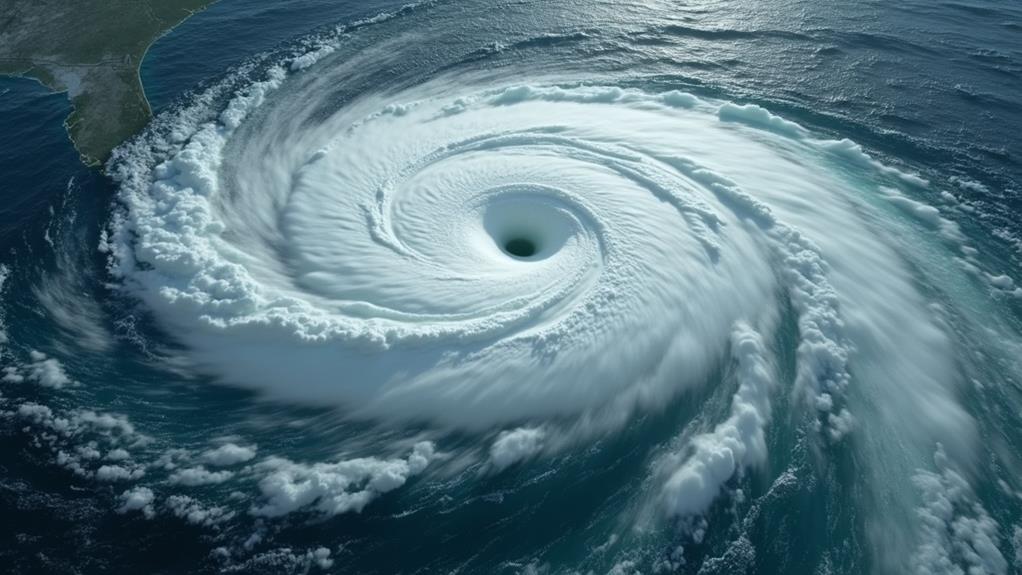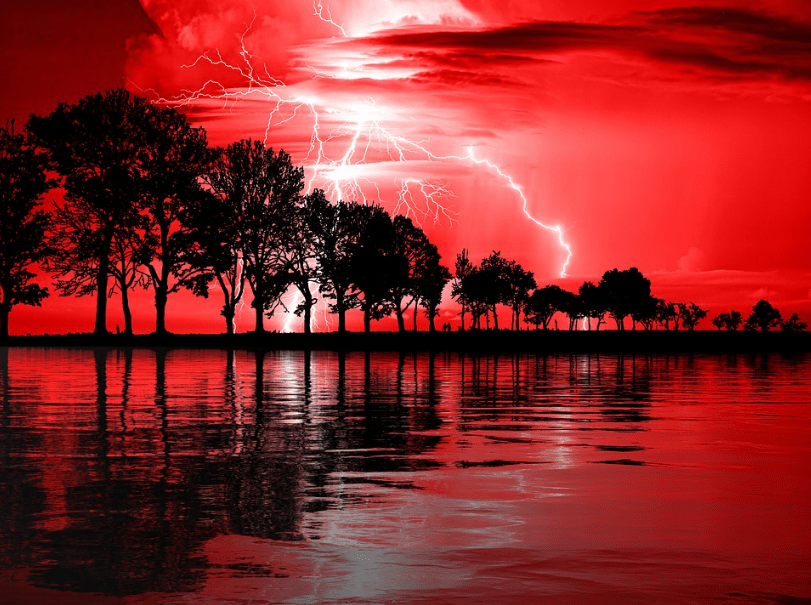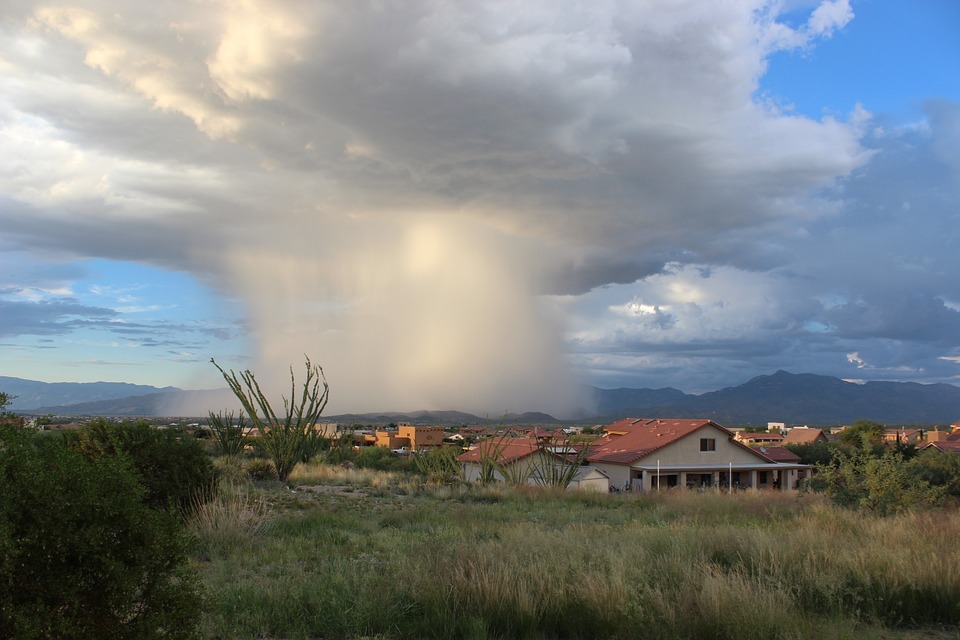What Causes an Off-season Hurricane?

You're curious about off-season hurricanes which pop up outside the usual June to November timeframe. These storms form when ocean waters are warmer than 79°F, and there's low vertical wind shear, allowing the system to organize. Atmospheric instability and the interaction between warm ocean surface and favorable wind patterns are key. Climate change, with rising ocean temperatures and shifting wind trends, might make these out-of-season hurricanes more frequent. If you're wondering about specific historical cases and their impacts, there's a lot more to learn.
Key Takeaways
- Warm ocean waters exceeding 26°C (79°F) provide the necessary heat energy for off-season hurricane formation.
- Low vertical wind shear allows for the organization and development of tropical cyclones outside the regular season.
- Atmospheric instability, with less stable air, promotes the rising of warm, moist air crucial for storm development.
- Favorable conditions in the central to western Atlantic during spring increase the likelihood of off-season hurricanes.
- Climate change, driving higher ocean temperatures and altering wind patterns, may lead to more frequent and intense off-season hurricanes.
Definition of Off-season Hurricanes
Off-season hurricanes in the Atlantic are tropical cyclones that hit outside the official hurricane season, which runs from June 1 to November 30. These storms are relatively rare but can still pack a punch. Since 1851, there have been 92 recorded off-season cyclones. Notably, May is the most common month for these events, accounting for about 60% of them. This showcases that while off-season hurricanes aren't frequent, they do have specific times when they are more likely to occur.
Peak hurricane activity typically happens between August and October, making off-season storms an anomaly. The strongest recorded off-season hurricane struck in March 1908, boasting sustained wind speeds of 100 mph. This illustrates that even outside the Atlantic hurricane season, tropical cyclones can still reach significant intensities.
Most off-season hurricanes don't make landfall, sparing coastal areas from potential damage. However, there are exceptions. For instance, a tropical storm in 1948 did make landfall, causing significant damage and fatalities. Understanding these off-season hurricanes helps you better prepare for the unexpected, even when you think the hurricane season is over.
Historical Data and Records
Historically, the data on off-season hurricanes reveals intriguing patterns and notable records. Since 1851, there have been 92 recorded off-season storms in the Atlantic basin. May stands out as the most common month for these tropical cyclones, accounting for approximately 60% of the occurrences. One standout year in history is 1887, which holds the record for the highest number of off-season storms, totaling five. Other notable years with multiple off-season storms include 1951, 2003, and 2007.
When examining the strength of these storms, the strongest off-season cyclone recorded was a hurricane in March 1908, with maximum winds reaching 100 mph. Another significant record is held by Hurricane Lili in 1984, which remains the longest-lasting off-season cyclone, persisting for a total of 12 days.
Off-season storms can also have a severe impact. For instance, a tropical storm in the Dominican Republic in 1948 resulted in a tragic death toll of 80. These historical records underscore that while off-season storms may be less frequent, their potential for significant impact is undeniable. Understanding the history of these events can help in preparing for future off-season hurricanes.
Atmospheric Conditions
When examining the atmospheric conditions that give rise to off-season hurricanes, several key factors come into play. Primarily, tropical development hinges on the presence of warm ocean waters. You need sea surface temperatures to exceed 26°C (79°F) to provide the necessary heat energy. This warmth fuels the development of low-pressure systems, which can evolve into off-season hurricanes.
Next, watch for wind shear. Low vertical wind shear is vital because strong upper-level winds can disrupt a storm's organization. When wind shear is minimal, it allows the storm to build and maintain its structure. In the central to western Atlantic Ocean, particularly in May, these conditions become more favorable as strong upper-level winds (westerlies) weaken and shift northward.
Atmospheric stability also plays a significant role. Warmer conditions in the upper atmosphere can inhibit storm formation by promoting atmospheric stability. However, when the atmosphere is less stable, it enables the rising of warm, moist air, which is critical for tropical development.
Oceanic Influences
Warm ocean waters are the lifeblood of off-season hurricanes, providing the vital heat and moisture needed for their development. When ocean waters exceed 26°C (79°F), you're looking at the perfect setting for tropical storm formation. This is particularly true in the central to western Atlantic Ocean, where oceanic conditions often pave the way for off-season hurricanes.
To paint a clearer picture, consider these factors:
- Warm Ocean Temperatures: In the spring, especially May, ocean waters warm up, creating ideal conditions for storm formation. May alone accounts for about 60% of off-season cyclone occurrences.
- Atlantic Niña: This phenomenon brings cooler waters, which usually mean fewer off-season hurricanes. However, warmer conditions in the absence of Atlantic Niña can lead to more intense tropical activity.
- Low Wind Shear: Minimal upper-level winds are fundamental. High wind shear can disrupt storm organization, making it critical for off-season development.
- Ocean Conditions: The interaction between temperature and wind patterns greatly affects storm formation. Favorable ocean conditions are a necessity for these storms to thrive.
Impact of Wind Shear

Wind shear plays a vital role in the development or suppression of off-season hurricanes. When wind shear is strong, it disrupts the organization of tropical storms, making it difficult for them to develop into more intense systems. This is particularly evident during the winter months, when off-season hurricanes are more likely to form.
In the off-season, strong westerly winds usually dominate regions like the Gulf of Mexico and the Caribbean Sea. These winds create unfavorable conditions for hurricane development by increasing wind shear. However, as spring approaches, these upper-level winds weaken and shift northward. This reduction in wind shear creates more favorable conditions for the development of off-season hurricanes, especially in May, which is the most common month for such storms.
Typically, off-season systems are less intense and fewer in number compared to those in the official hurricane season. This is largely due to the higher wind shear present during these times. Monitoring wind patterns continuously is critical for predicting off-season storm development. A decrease in wind shear can greatly improve the likelihood of tropical cyclones forming outside the traditional hurricane season.
Role of Climate Change
Due to the ongoing impacts of climate change, the frequency and intensity of hurricanes are believed to be shifting, potentially leading to more off-season storms. As ocean temperatures rise, particularly above the 26°C threshold, the potential for hurricane formation increases year-round. This warming trend is a crucial factor because it creates favorable conditions for tropical development even outside the official hurricane season.
Increased atmospheric warmth can also play a role. While it may disrupt typical storm formation patterns, it can likewise influence the timing and occurrence of off-season hurricanes. Fundamentally, these changes can lead to a more stable upper atmosphere, which affects how and when storms form.
To visualize this, consider how climate change impacts hurricanes:
- Increasing Ocean Temperatures: Warmer waters fuel hurricanes, making them more likely to form off-season.
- Enhanced Atmospheric Warmth: Warmer air can disrupt normal storm patterns but also shift the timing of storm formation.
- Altered Wind Patterns: Changes in wind due to climate patterns can affect how and where hurricanes develop.
- Reassessed Historical Data: New analysis shows rising oceanic and atmospheric conditions could increase off-season hurricane frequency and intensity.
Notable Off-season Hurricanes

Understanding the impact of climate change on hurricane patterns lays the groundwork for examining specific instances of off-season hurricanes. One of the most notable is Hurricane Lili, which struck in 1984 and lasted an impressive 12 days, making it the longest off-season hurricane on record. This extensive duration highlights the persistence and unpredictability of tropical storms outside the traditional hurricane season.
Hurricane Epsilon also made waves in 2005 by maintaining hurricane status for five days in December, setting a new record for late-season intensity. These hurricanes exemplify the surprising strength and longevity that off-season tropical storms can exhibit.
Another critical example occurred in 1948 when a tropical storm hit the Dominican Republic. This storm resulted in significant fatalities, with a tragic death toll of 80, underscoring the severe human impact that off-season hurricanes can have. The economic impact of these storms is also notable. For instance, the November 1925 tropical storm caused an estimated $3 million in damages.
Furthermore, the year 1887 stands out for having the highest number of off-season storms, totaling five. These historical instances demonstrate the varied and sometimes devastating nature of off-season hurricanes.
Economic and Social Impacts
Off-season hurricanes can wreak havoc on both economies and societies, leaving lasting scars that go beyond immediate destruction. These rare storms catch communities off guard, leading to significant economic impacts and social disruption. For instance, Hurricane Alberto (2018) caused $125 million in damages, while Tropical Storm Olga (2007) resulted in $45 million in reported damages. Such financial hits can cripple local economies, affecting everything from infrastructure to small businesses.
Consider the following impacts:
- Economic Damages: Hurricane Alice (1954) caused around $623,000 in damages, straining local resources and budgets.
- Social Costs: The 1948 tropical storm in the Dominican Republic led to a tragic death toll of 80, underscoring the human cost of off-season storms.
- Community Disruption: Tropical Storm Arlene (1959) left $500,000 in damages, highlighting how recovery costs can linger.
- Unpredictability: The rarity and unpredictability of these hurricanes make preparedness challenging, destabilizing both economic stability and community resilience.
These off-season hurricanes remind us that the impacts are multifaceted, affecting every layer of the community. By understanding these economic and social ramifications, you can better appreciate the importance of preparedness and resilience in the face of these unpredictable storms.
Frequently Asked Questions
Has an Atlantic Hurricane Ever Formed off Season?
Yes, an Atlantic hurricane has formed off season. Since 1851, 92 off-season tropical cyclones have been recorded. Off-season storms often result from unusual patterns in ocean temperatures and atmospheric conditions. Climate change may also influence hurricane formation outside the typical season. Notable examples include Hurricane Lili (1984) and Hurricane Epsilon (2005). These hurricanes demonstrate how unpredictable and significant these off-season events can be.
Has There Ever Been a Hurricane Season With No Hurricanes?
You might wonder if there's ever been a hurricane season with no hurricanes. Based on historical data, there's never been a full season without at least one hurricane. Hurricane patterns, influenced by ocean temperatures, meteorological factors, and climate change, guarantee some activity. Seasonal forecasts, even with variations, always predict some storm intensity. So, while off-season hurricanes are rare, the official season always records at least one storm.
Has There Ever Been a Hurricane in the Winter?
Yes, there have been winter hurricanes. Historical records show that tropical cyclones can form due to off-season patterns and meteorological anomalies. Winter hurricanes, although rare, have occurred, such as the one in March 1908 and Hurricane Lili in December 1984. Climate change effects may influence hurricane formation outside the typical season, leading to these unusual events. These instances highlight the complexity of predicting off-season hurricane activity.
How Bad Is Hurricane Season Going to Be in 2024?
You might say the 2024 hurricane season could be "a bit lively" due to shifting climate conditions. Experts in hurricane forecasting are eyeing climate change, ocean temperatures, and atmospheric pressure. Historical patterns show peak activity between August and October, so that's when you should be most on alert. Preparation strategies and public awareness will be essential, with the National Hurricane Center providing vital updates to keep everyone informed and ready.




